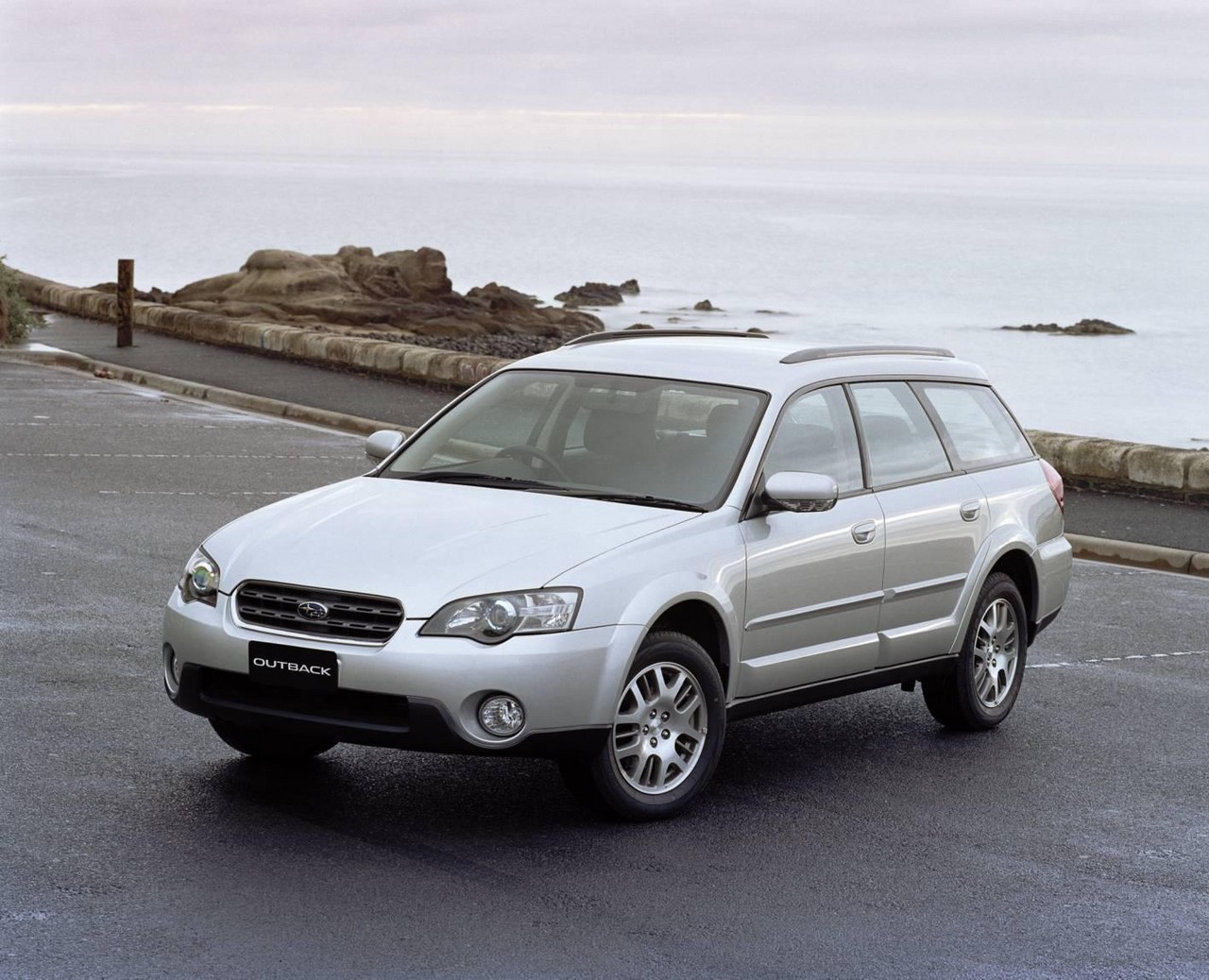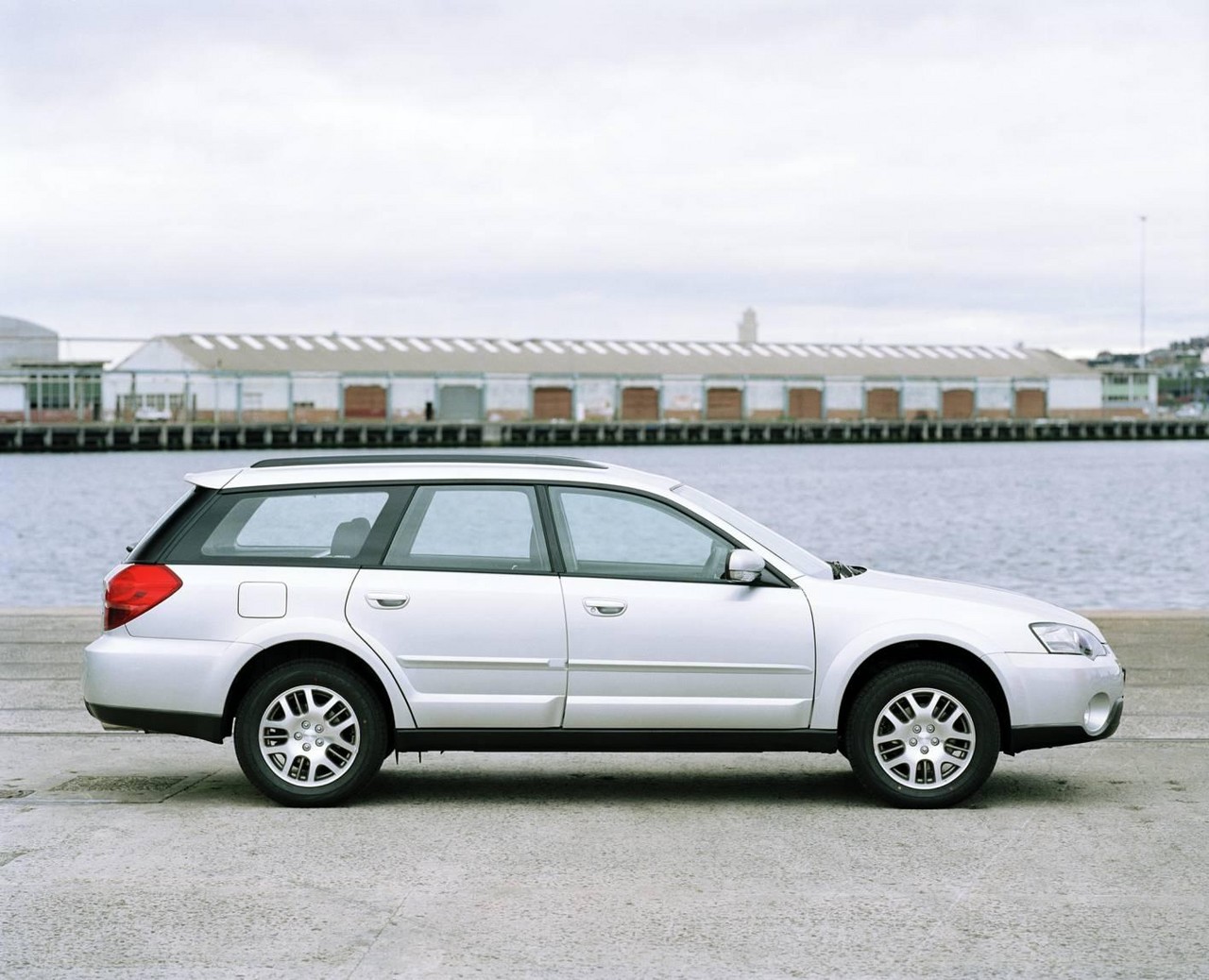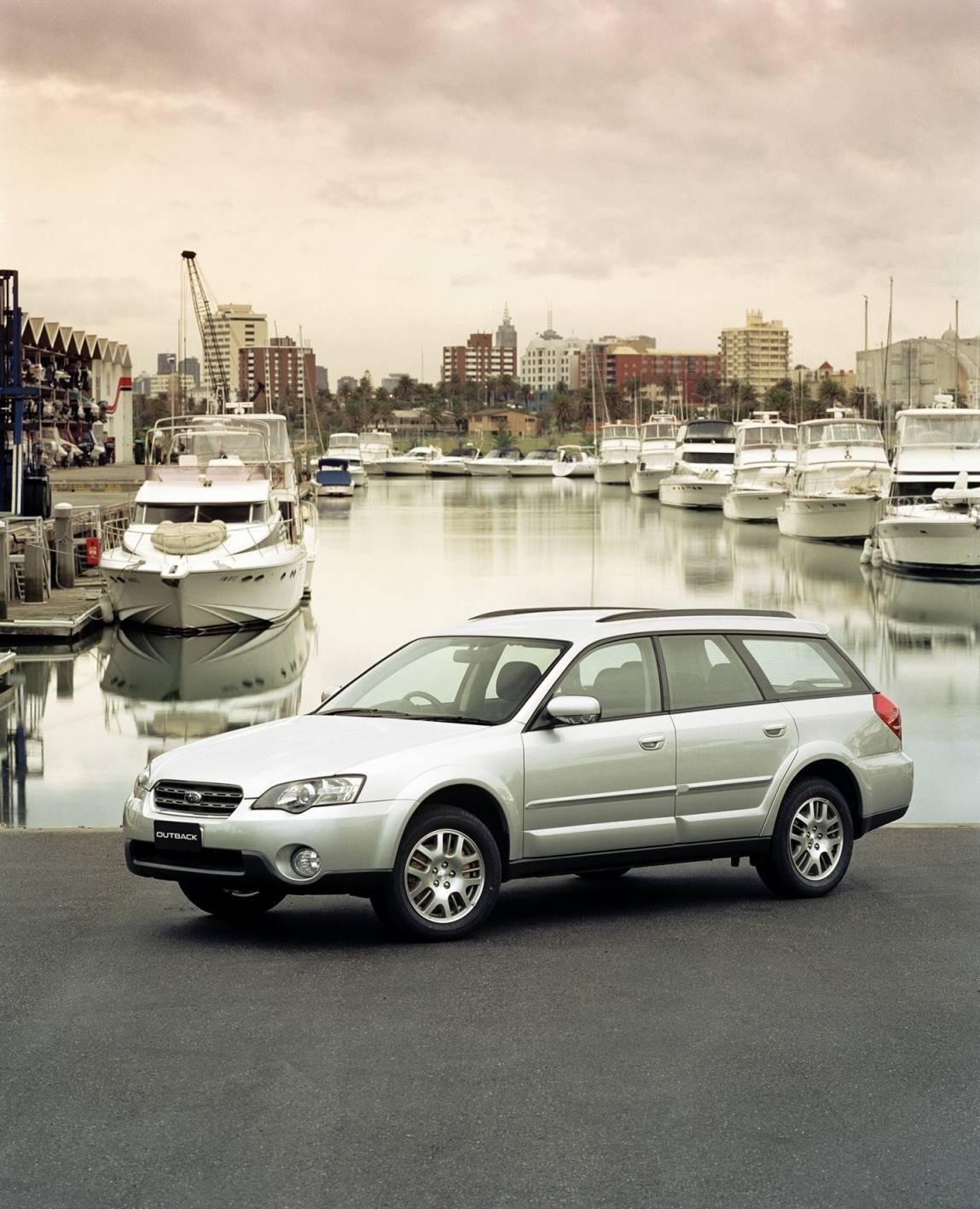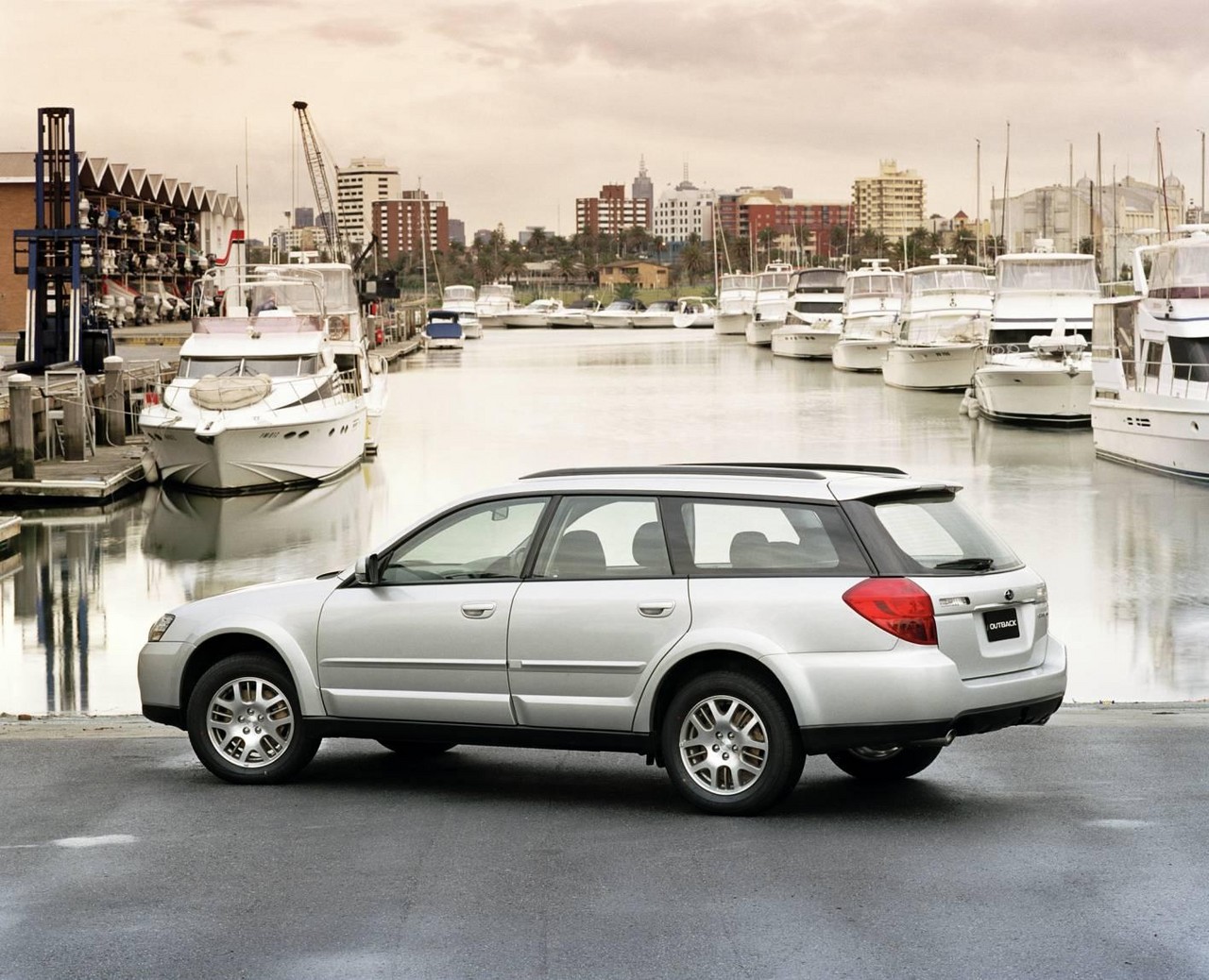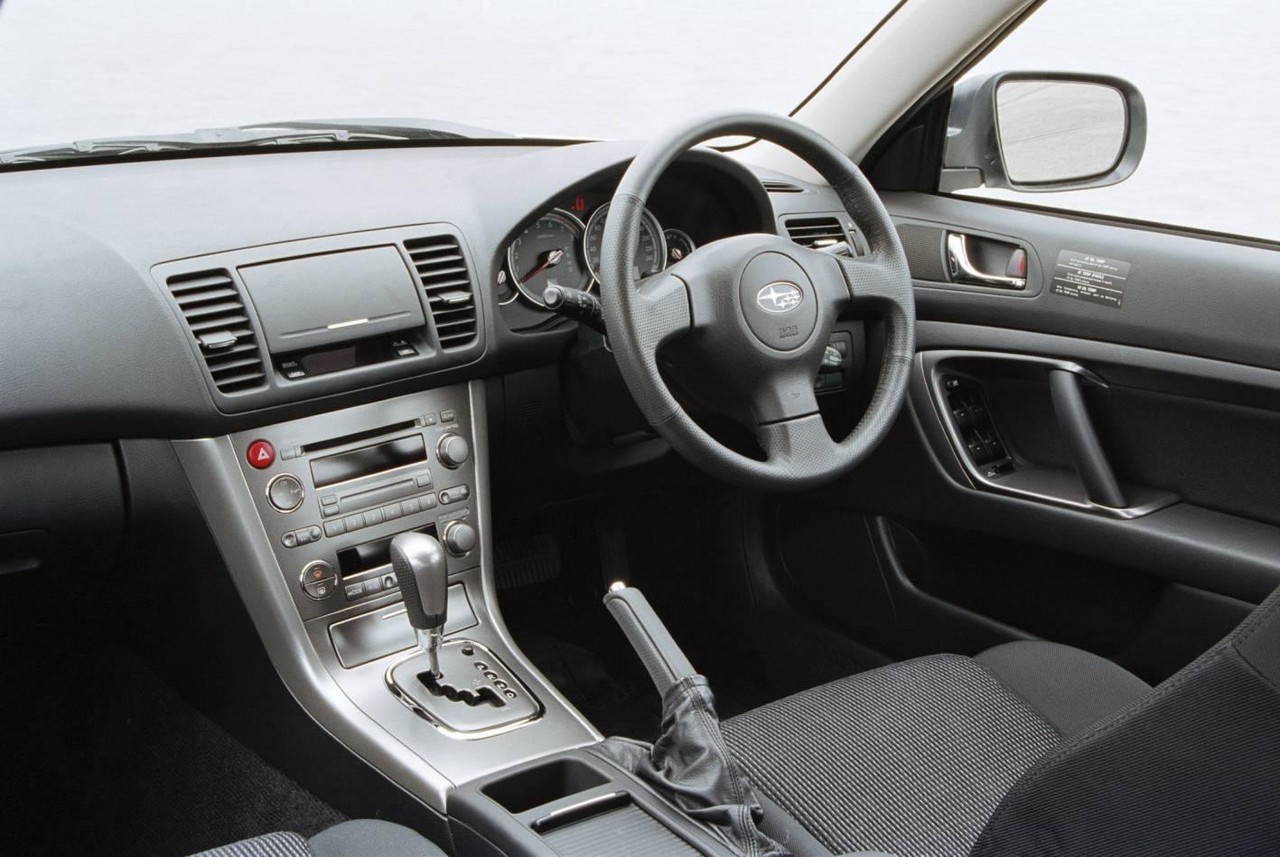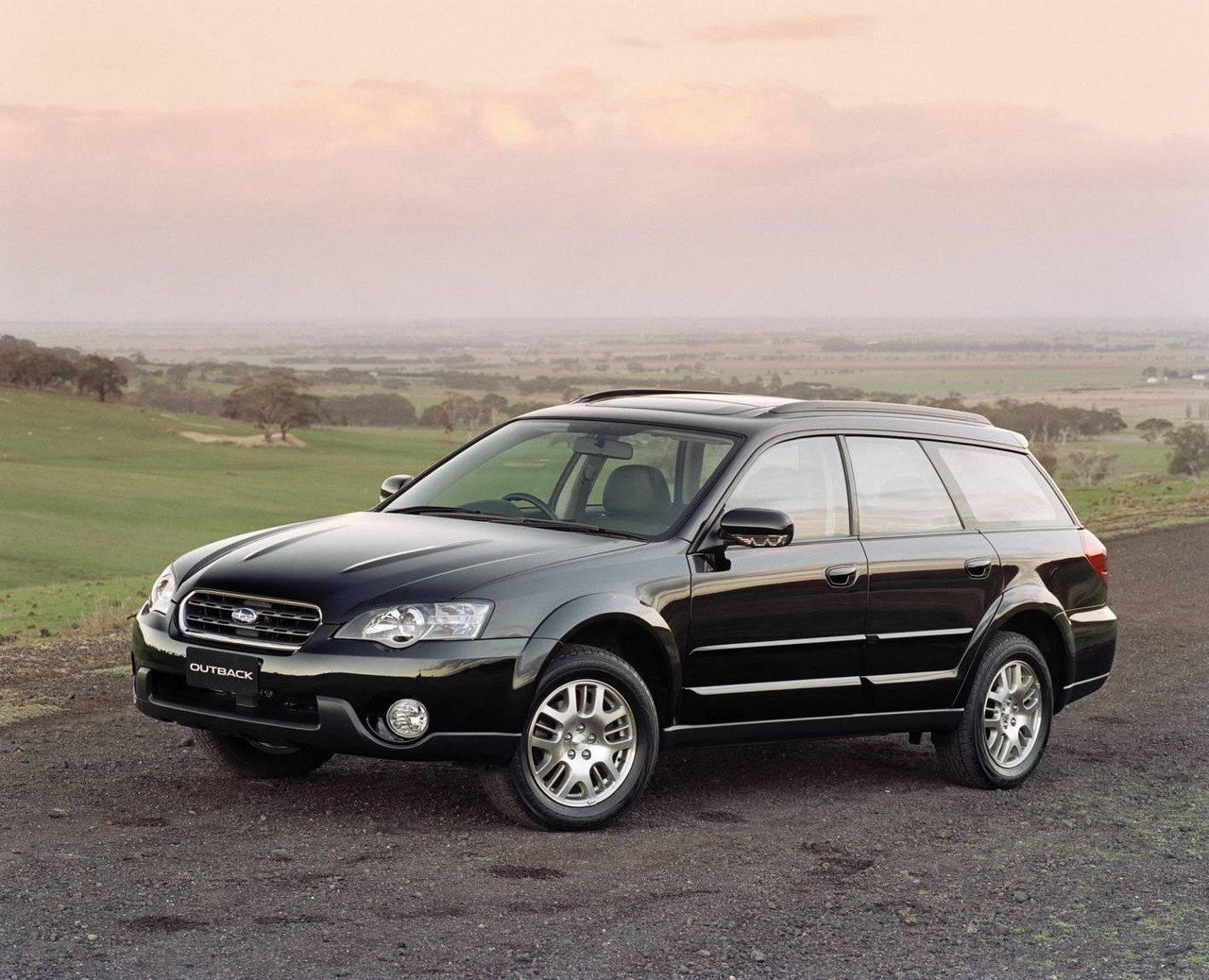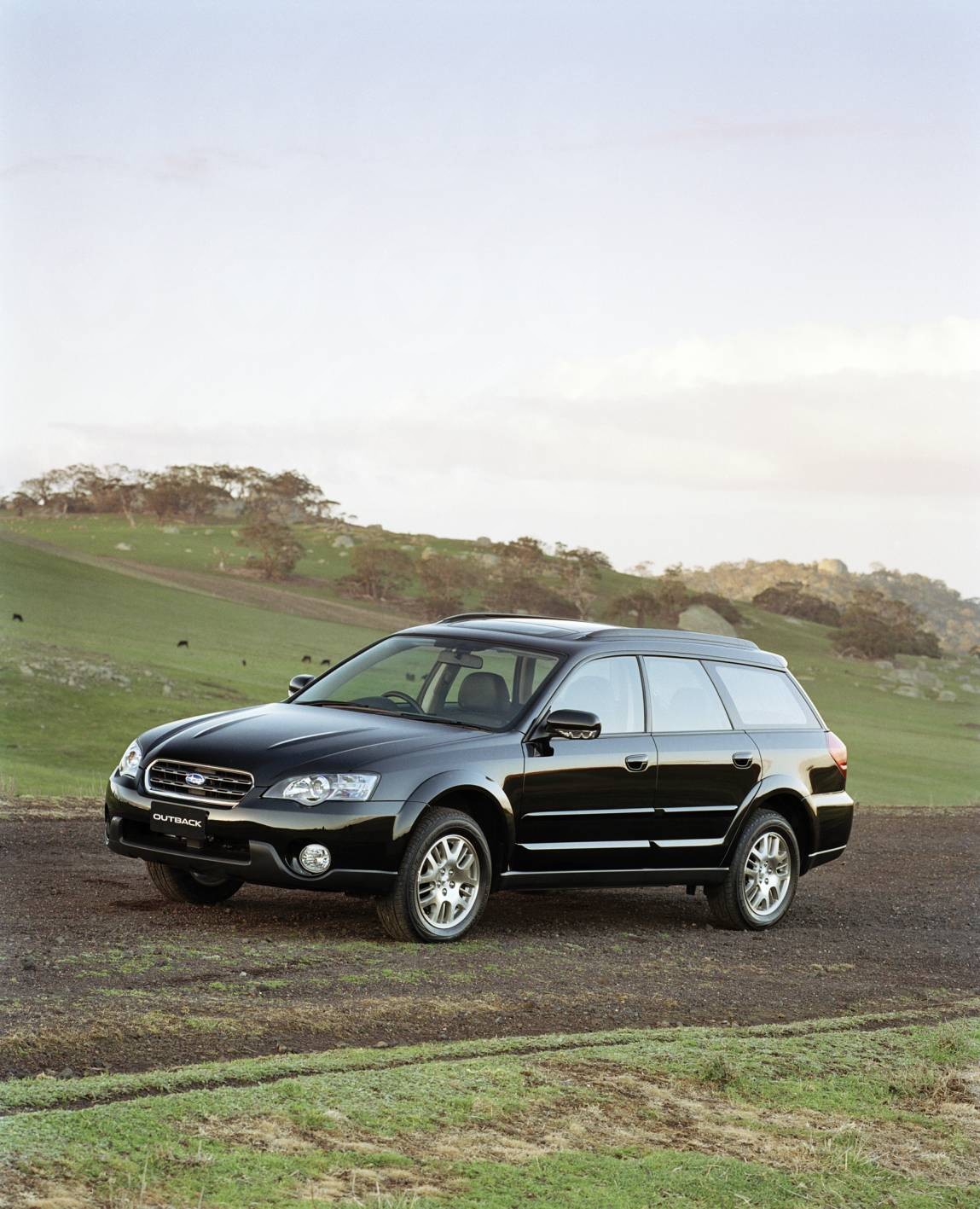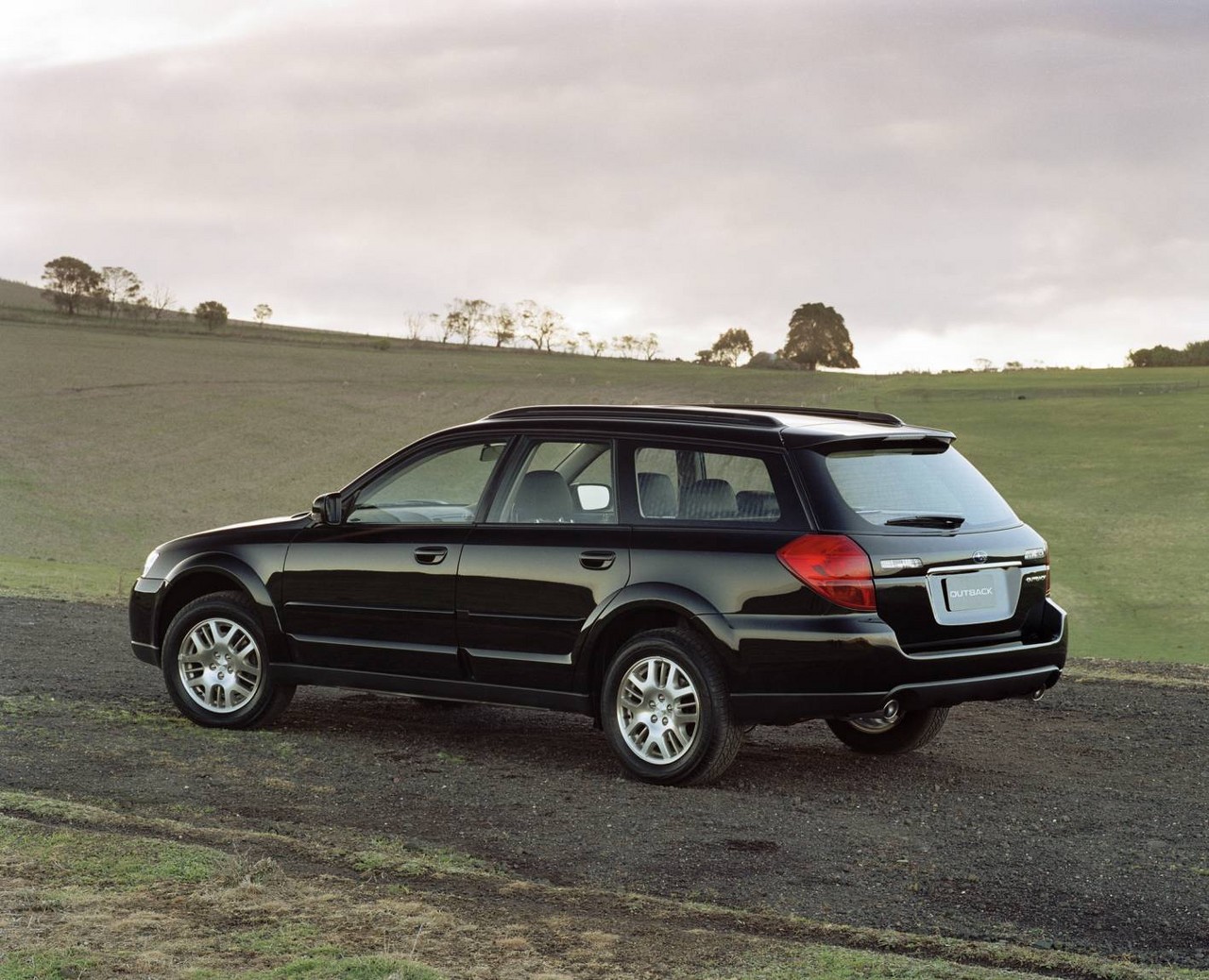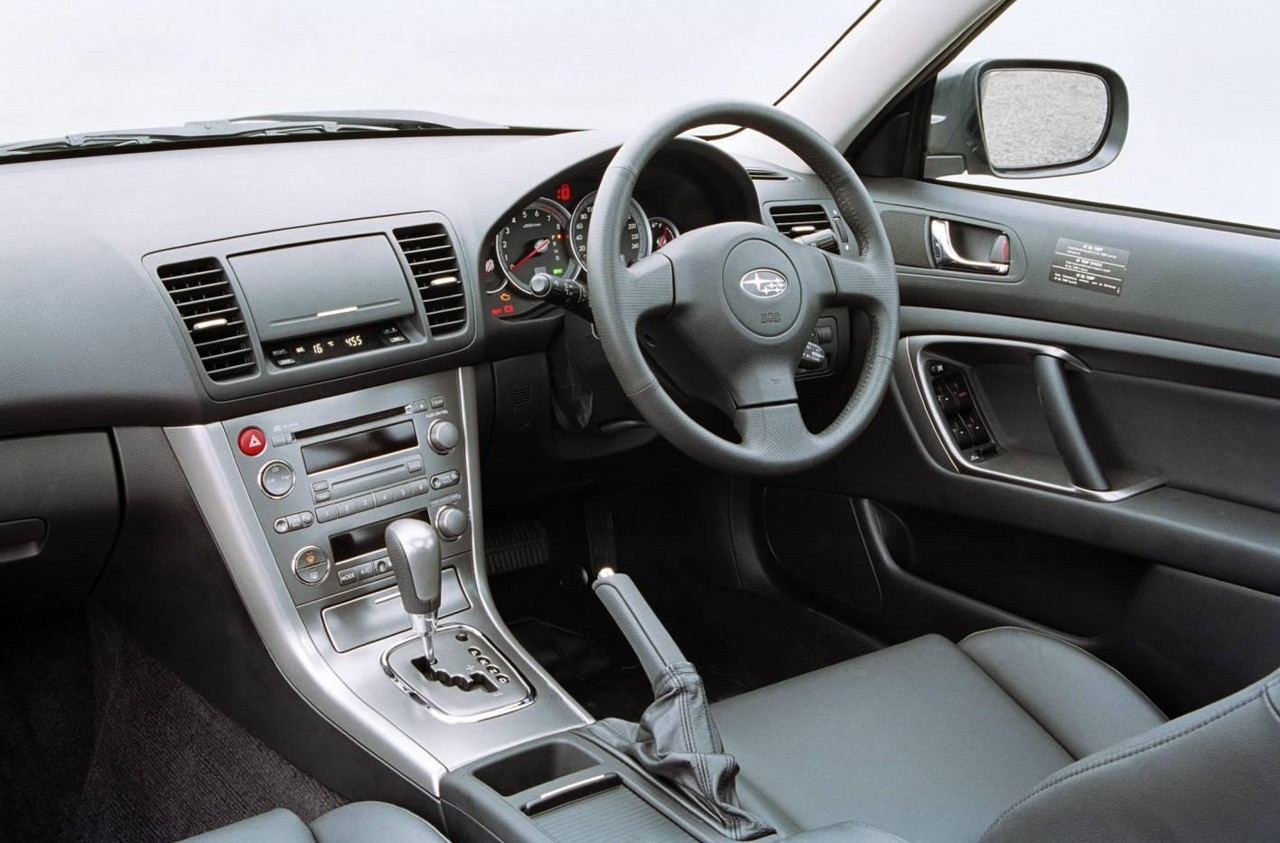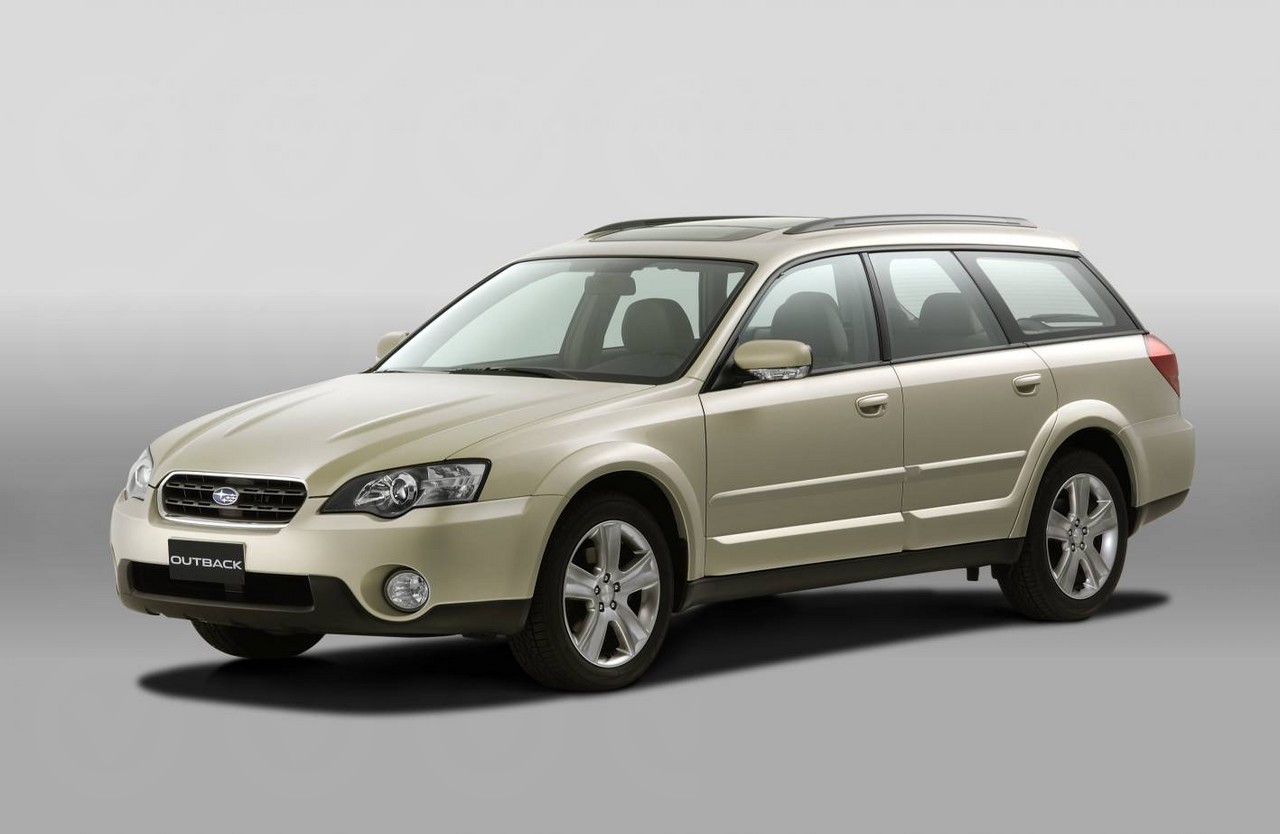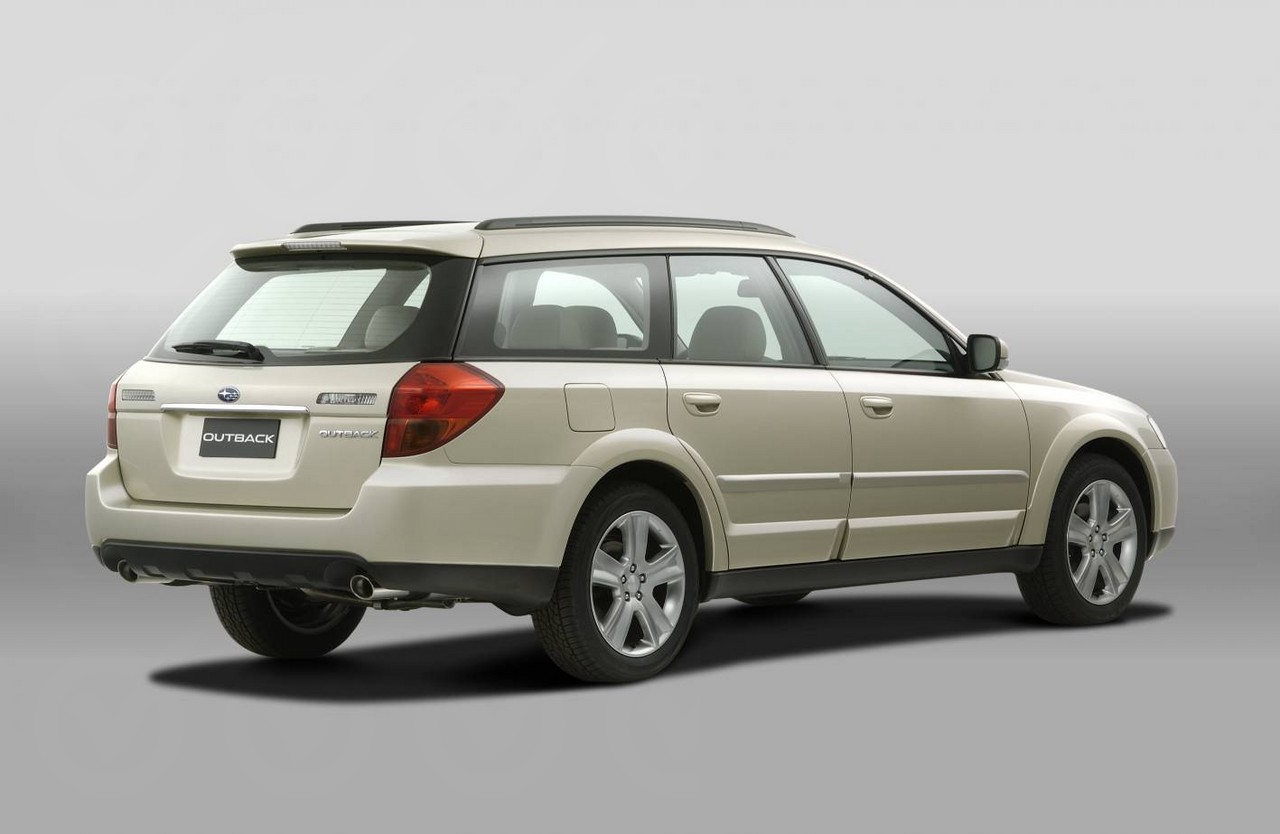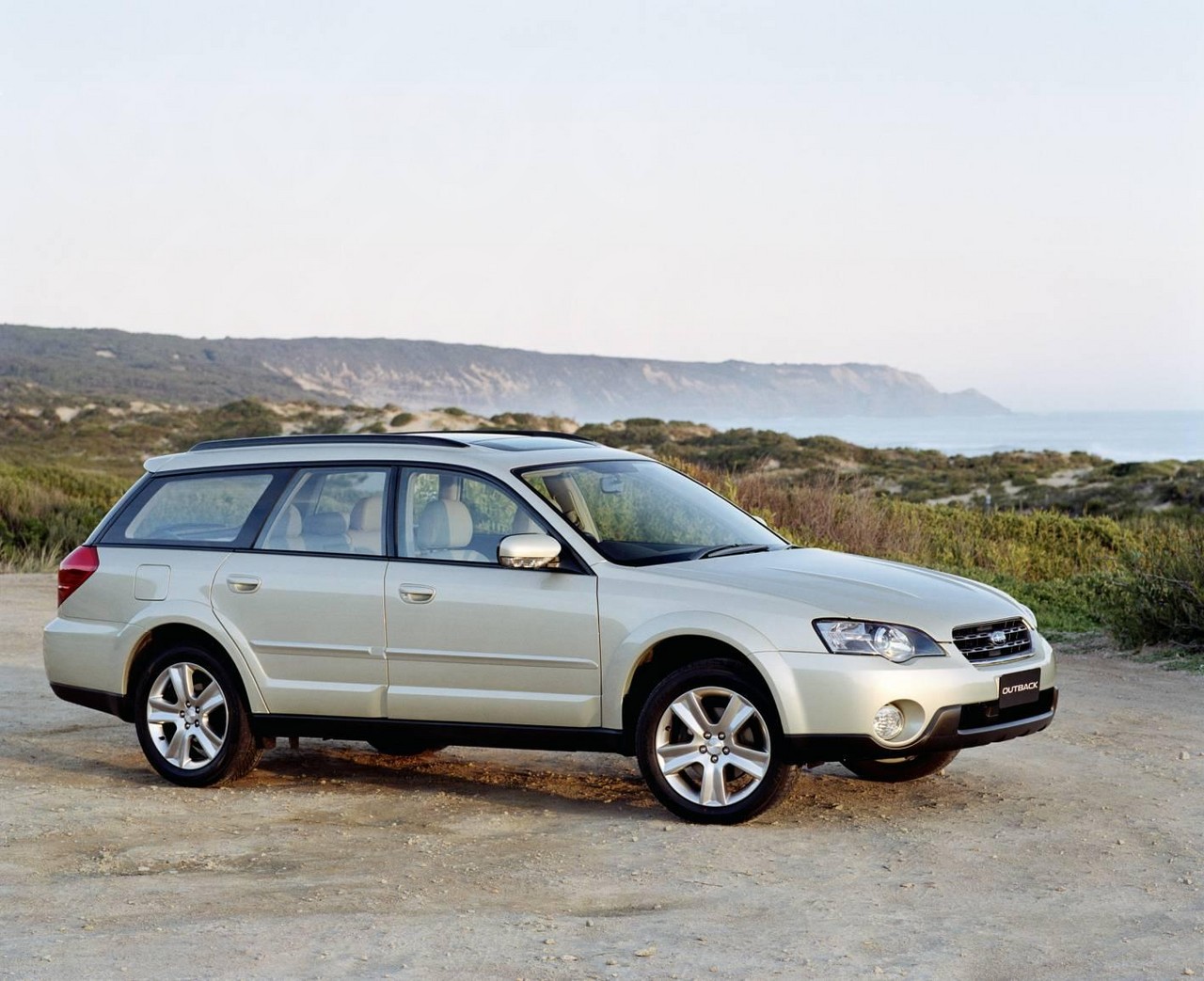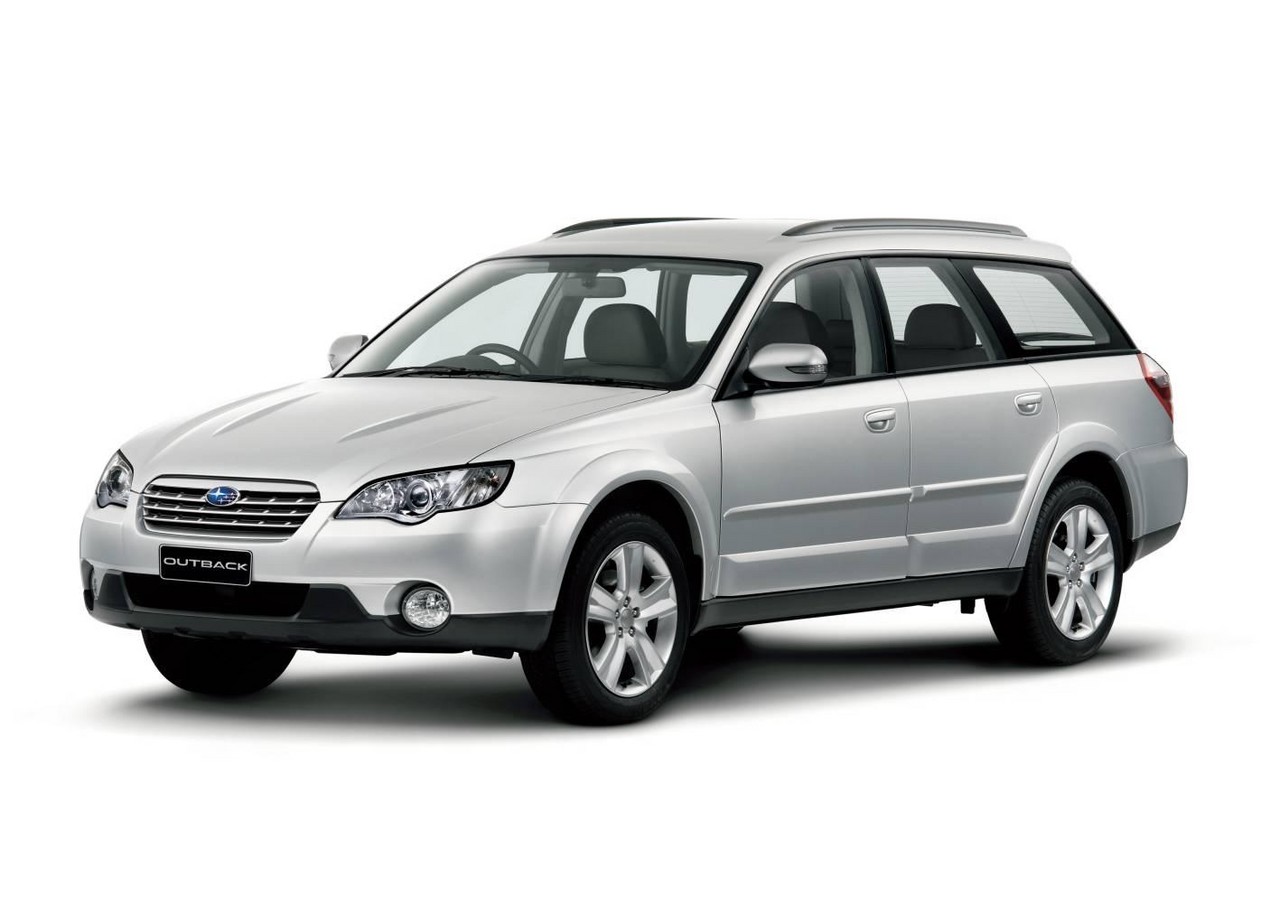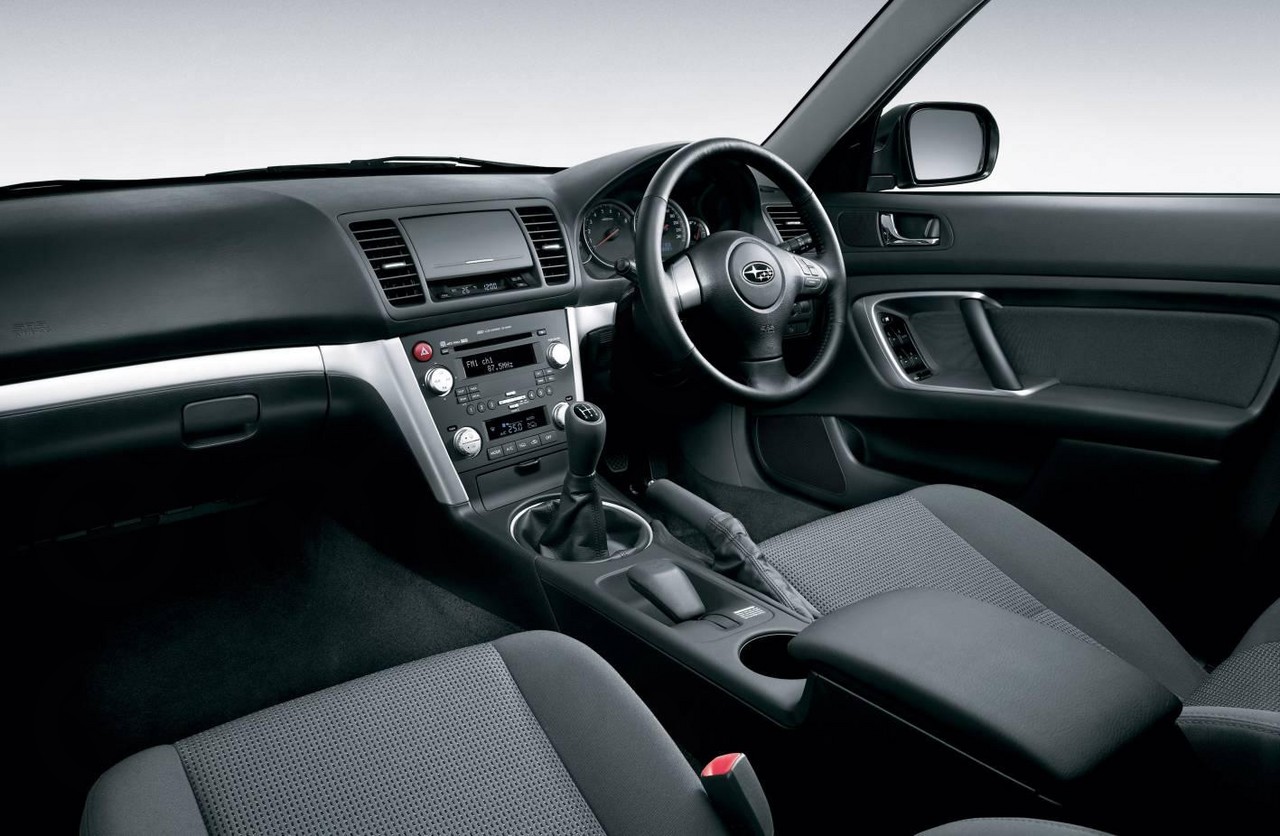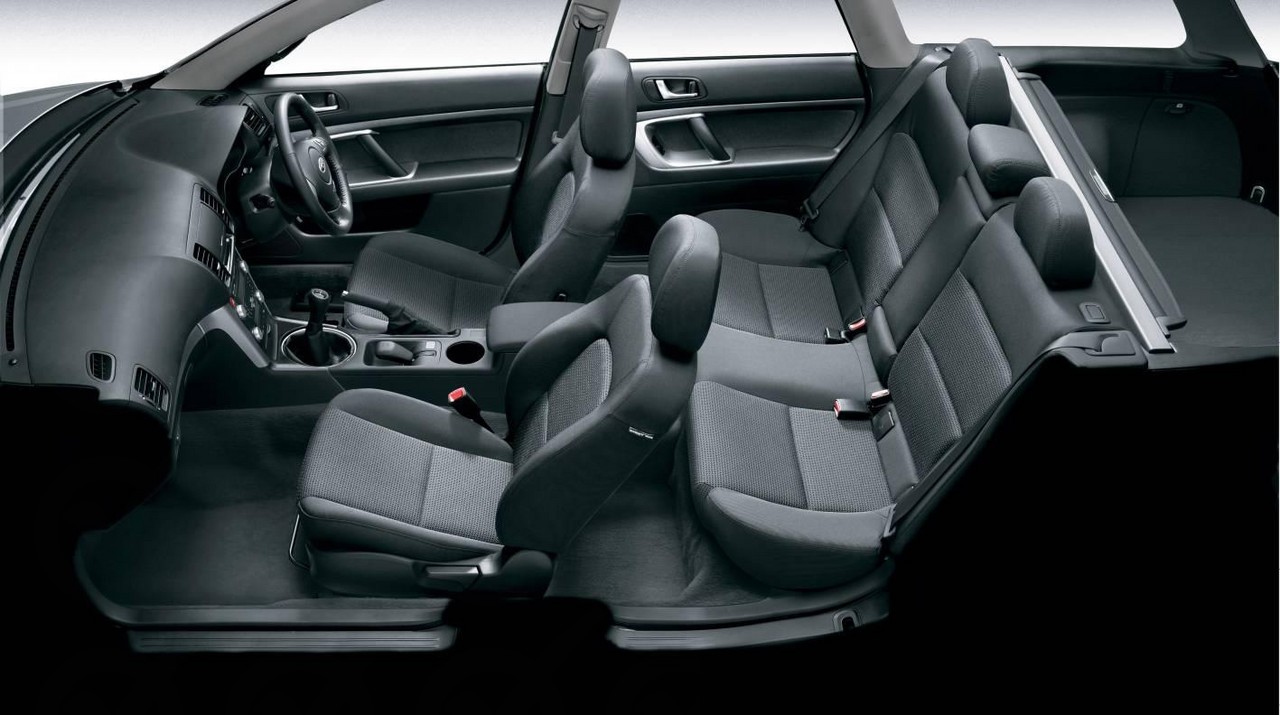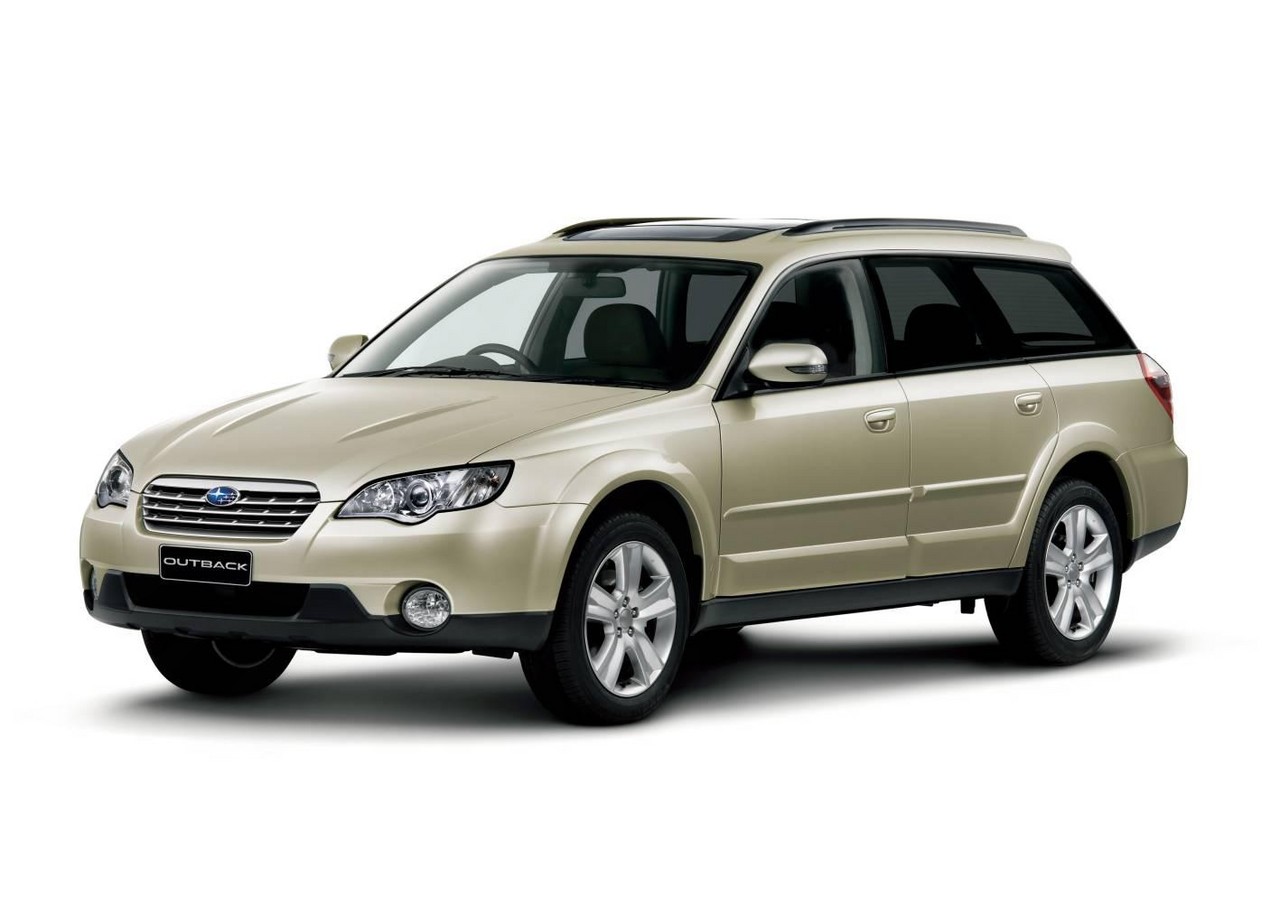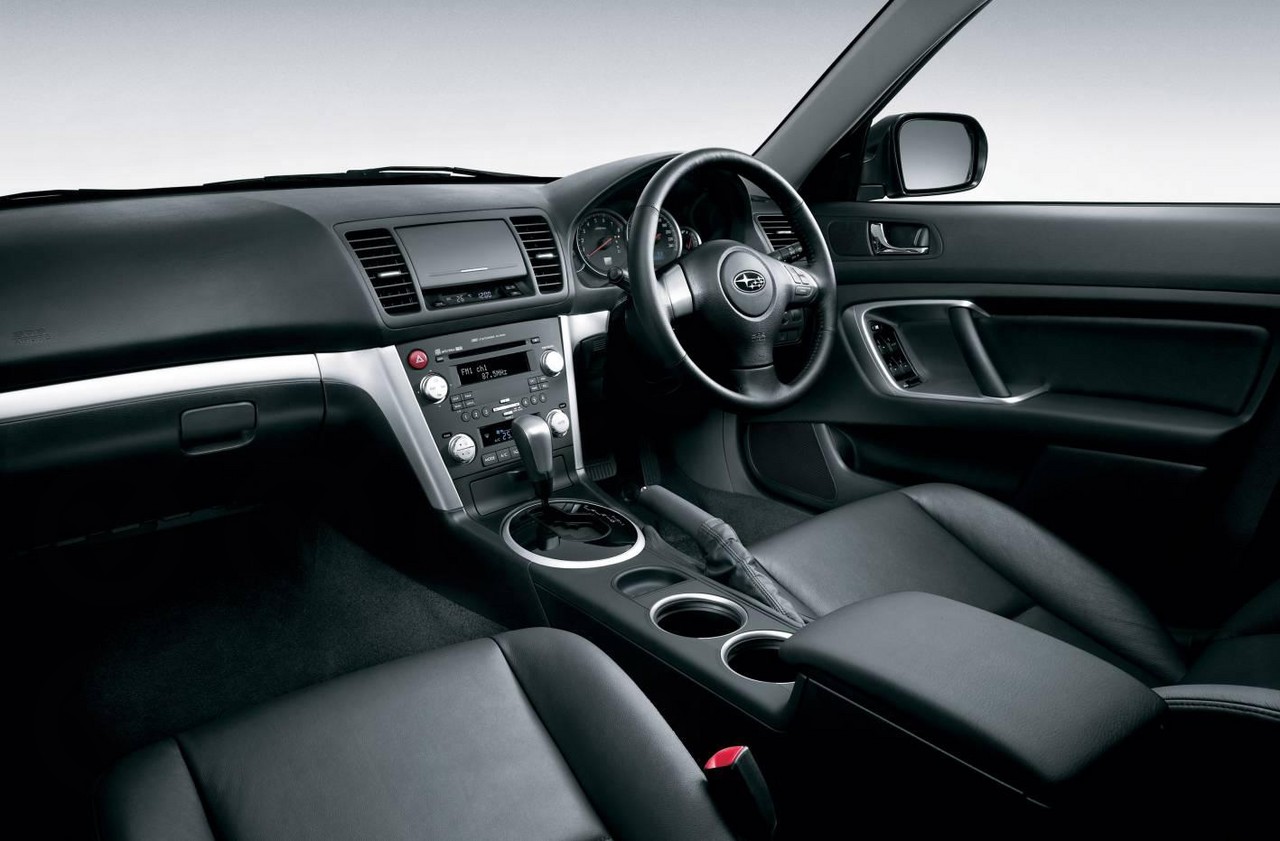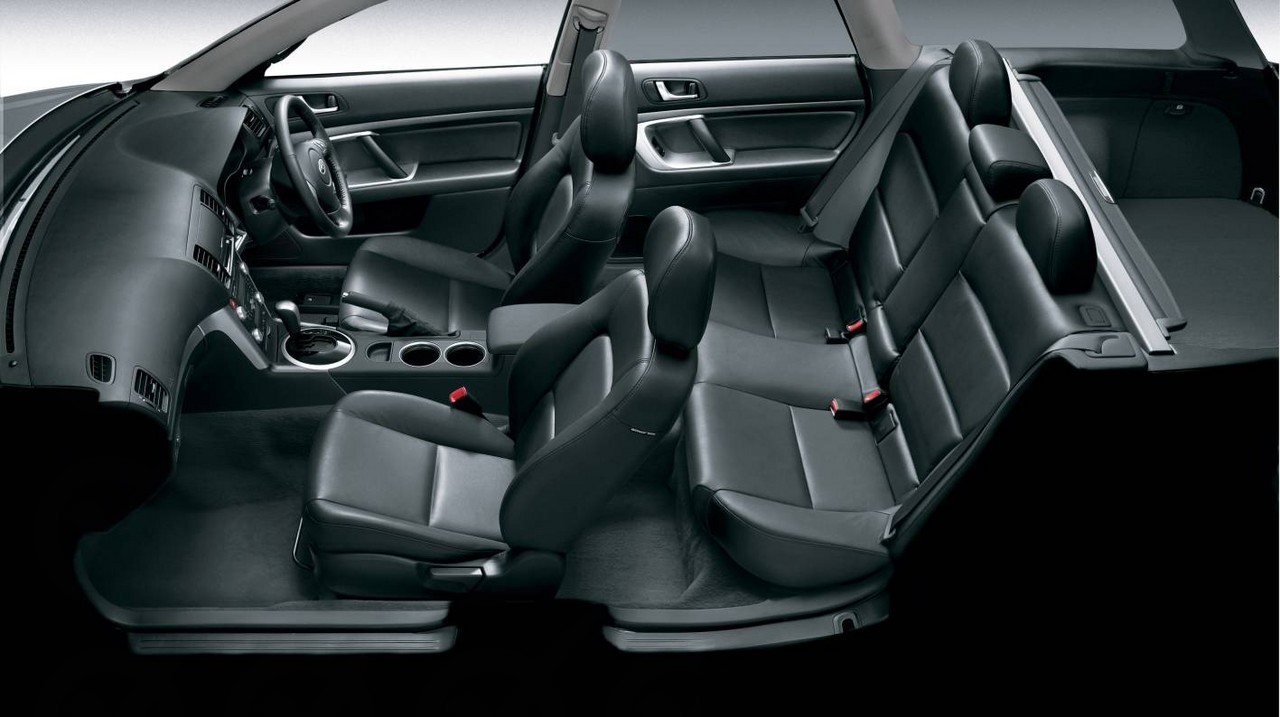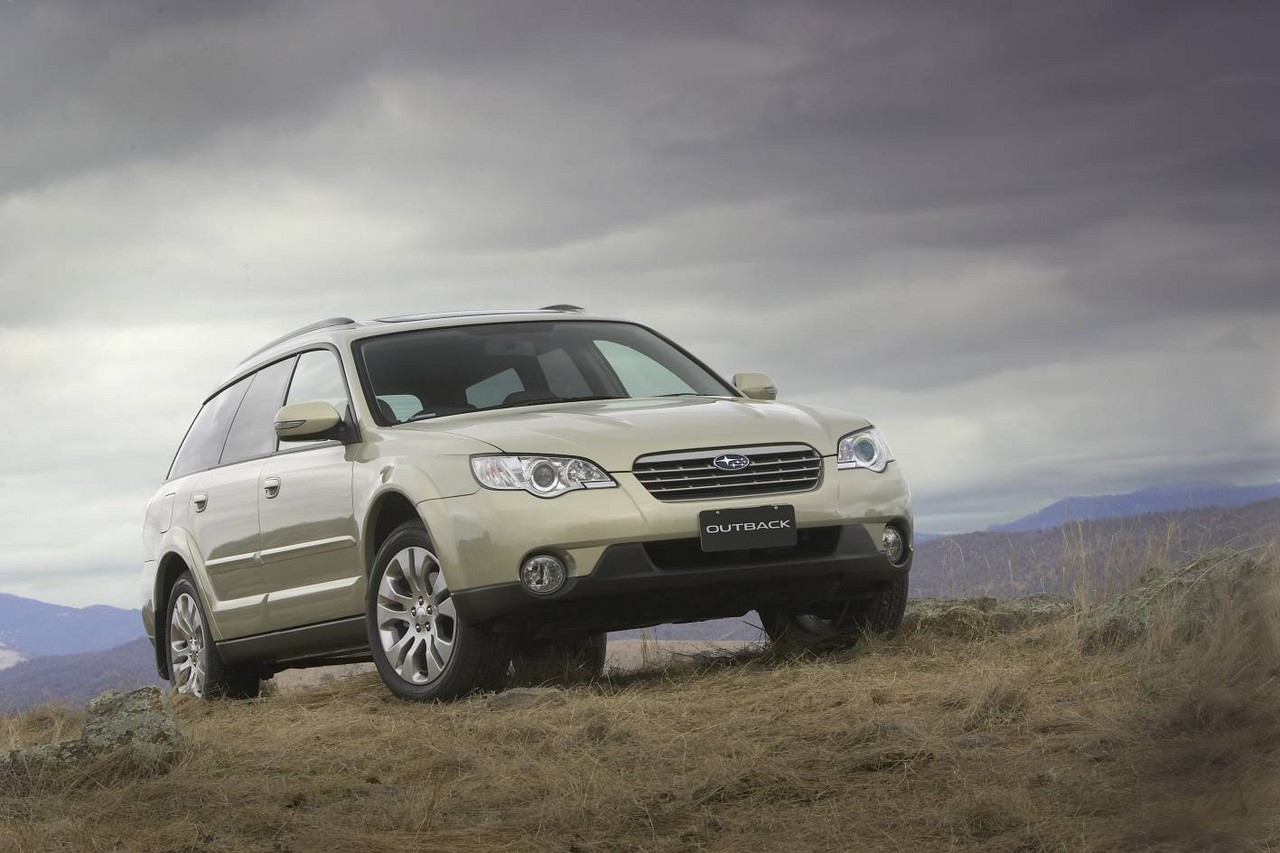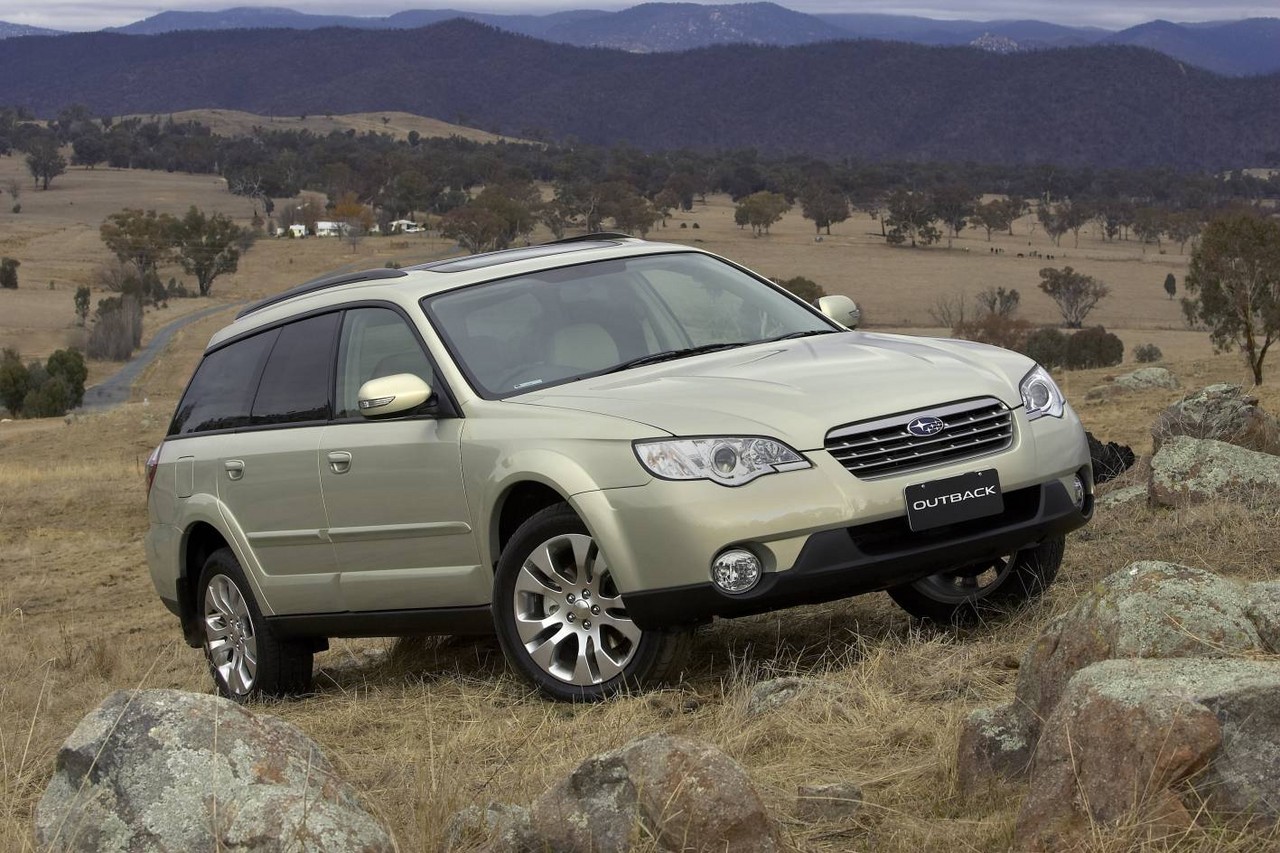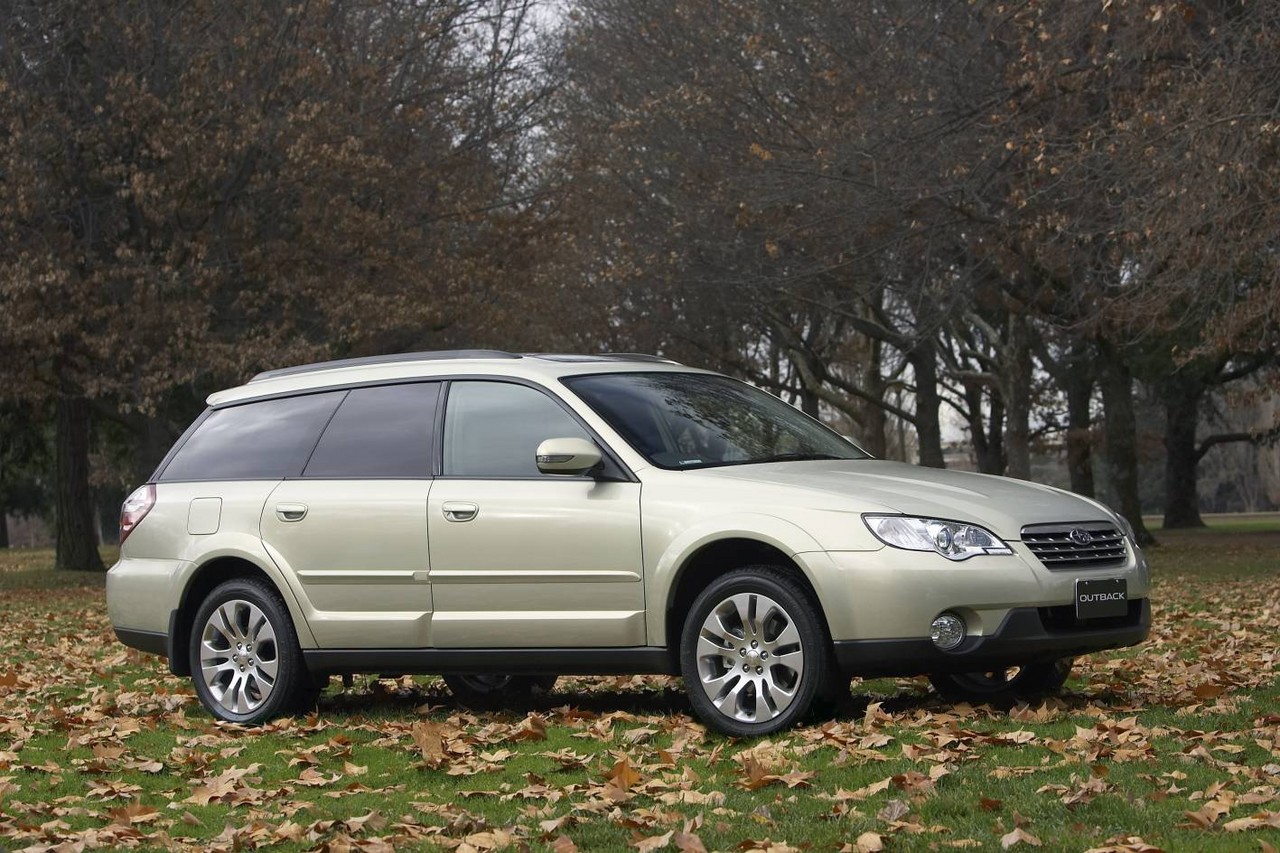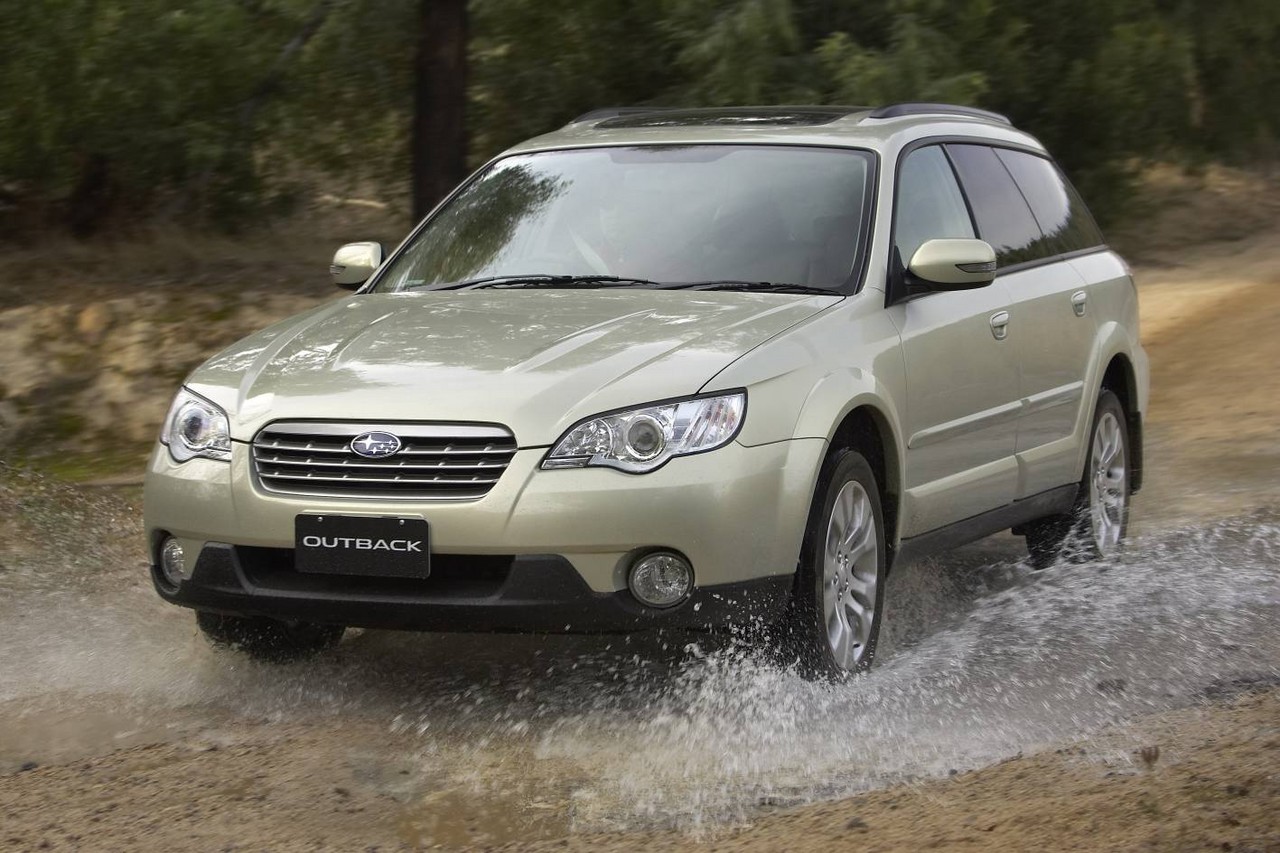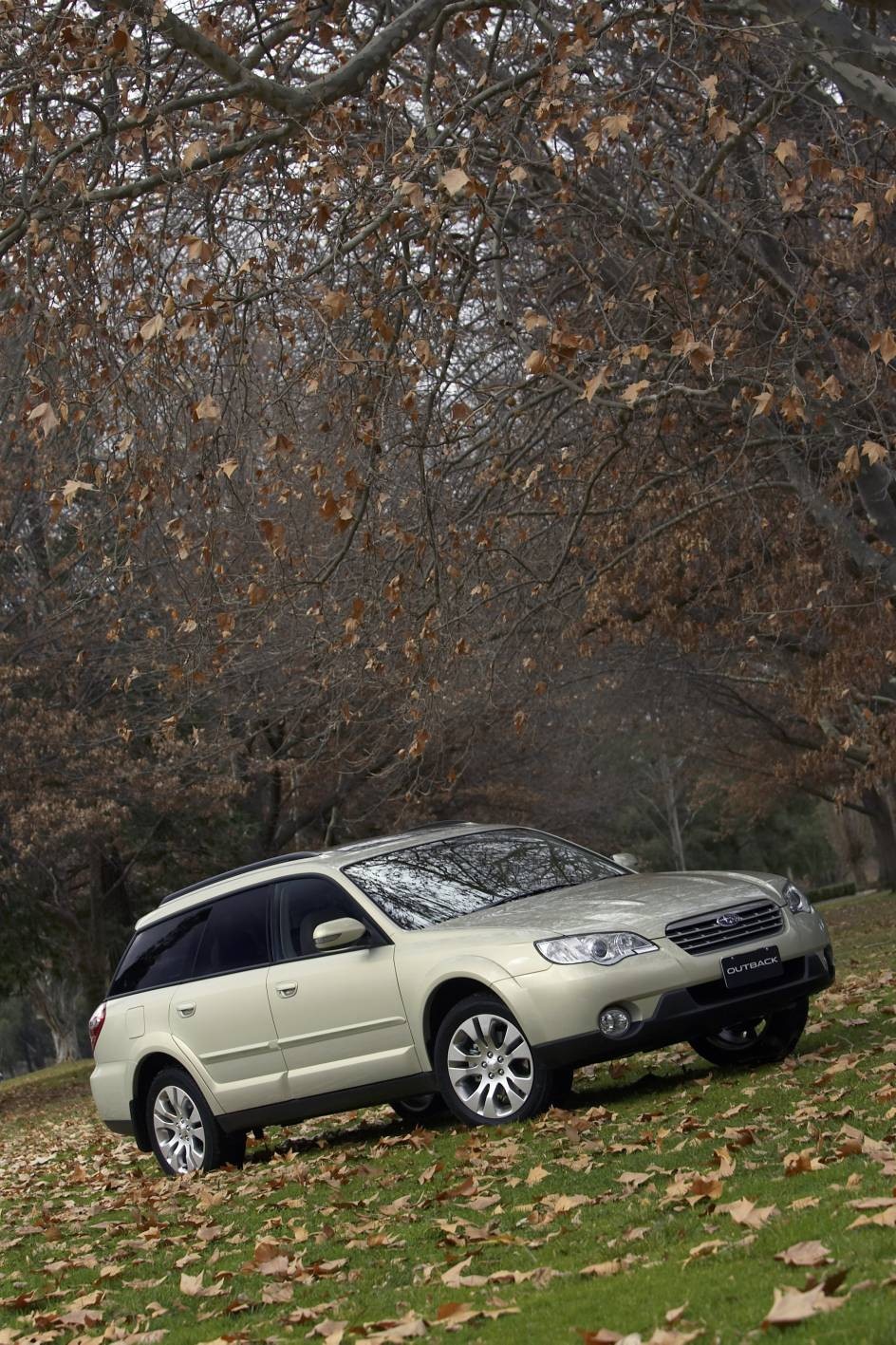
- All-wheel drive traction (via three different systems)
- Accomplished ride/handling balance
- Accurate steering provides good feedback
- High standard of interior fit and finish
- Front seats are supportive…
- … but narrow
- 2.5-litre petrol engine lacks low-rev torque
- Standard all-terrain tyres lack on-road grip
- 2.5-litre EJ25 engine susceptible to head gasket failure
Review: Subaru BP.I Outback (2003-06)
Overview
Released in September 2003, the Subaru BP Series I (BP.I) Outback was a five-seat, all-wheel drive wagon. Manufactured in Ota, Japan, the Subaru BP Outback range initially consisted of the 2.5i variants, which were powered by a 2.5-litre horizontally-opposed (or flat) four-cylinder petrol engine. In October 2003, however, the range was expanded with the Outback 3.0R which was powered by a 3.0-litre six cylinder engine.
EJ252 and EZ30R engines
For the Outback 2.5i, the 2.5-litre EJ252 engine had an open-deck aluminium alloy block with cast iron liners, an aluminium alloy cylinder head, a single overhead camshaft per cylinder bank (belt-driven), four valves per cylinder actuated by shimless buckets, multipoint sequential fuel injection and a compression ratio of 10.1:1.
For the Outback 3.0R, the 3.0-litre EZ30R engine had an open deck aluminium alloy block with cast iron liners, an aluminium alloy cylinder head, double overhead camshafts (chain-driven), four valves per cylinder, variable intake valve timing (Subaru’s ‘Active Valve Control System’ or AVCS), variable intake valve lift (Subaru’s ‘Variable Valve Lift’ or VVL) and a compression ratio of 10.7:1.
Dimensions and body
Compared to the BH Outback , the BP Outback was 10 mm longer (at 4730 mm), 25 mm wider (1770 mm), 45 mm lower (1545 mm) and had a 20 mm longer wheelbase (2670 mm). Furthermore, the BH chassis achieved a 10 per cent increase in torsional rigidity through the introduction of a ring-shaped reinforcement body frame, tailored blank welding, hydro forming and new materials such as high tensile steel and aluminium – these changes also resulted in an approximate mass reduction of 60 kg.
Suspension
Like the BP Liberty wagon on which it was based, the BP Outback had MacPherson strut front suspension and multi-link rear suspension.
| Variant | Editions | Years | Engine | Trans. | Peak power | Peak torque |
|---|---|---|---|---|---|---|
| 2.5i | [N/A] | 2003-06 | 2.5-litre EJ252 petrol F4 | 4sp auto, 5sp man. |
121 kW at 5600 rpm | 226 Nm at 4400 rpm |
| Luxury Pack | 2003-04 | |||||
| Premium Pack | 2003-06 | |||||
| Safety Pack | 2004-06 | |||||
| Touring | 2006 | |||||
| Luxury | 2006 | |||||
| Duotone | 2006 | |||||
| 3.0R | [N/A] | 2003-06 | 3.0-litre EZ30R petrol F6 | 5sp auto | 180 kW at 6600 rpm | 297 Nm at 4200 rpm |
| Premium Pack | 2003-06 | |||||
| Duotone | 2006 |
AWD systems
The Subaru BP Outback was available with three different all-wheel drive (AWD) systems:
- Models with manual transmissions were fitted with Subaru’s ‘Continuous’ AWD system which utilised a viscous-coupling locking centre differential. In normal conditions, the system provided a 50:50 front:rear torque distribution. If traction was lost, however, up to 80 per cent of the engine’s torque could be directed to the opposing axle. The manual models were also equipped with dual range transmissions.
- For the 2.5i variants with automatic transmissions, an ‘Active Torque Split’ system was fitted, consisting of an electronically-controlled, hydraulic multi-plate transfer clutch (instead of the centre differential). In normal conditions, the system provided an 80:20 front:rear torque split but sensors – measuring wheel slippage, throttle position and braking – could anticipate a loss of front-wheel traction and transfer torque to the rear axle.
- For the 3.0R variants, a ‘Variable Torque Split’ system was fitted – this system utilised an electronically-controlled, hydraulic multi-plate clutch which operated in conjunction with the centre planetary-type differential. In normal conditions, the system provided a 45:55 front:rear torque split, though sensors – monitoring wheel slippage, throttle position and braking – could determine the amount of clutch lock to apply.
Safety equipment
Standard safety equipment for the Subaru BP.I Outback included dual front airbags, ABS, electronic brake force distribution, active front seat head restraints and front seatbelts with pretensioners and load limiters. The 2.5i Premium Pack, 2.5i Safety Pack and 3.0R Luxury Pack models were further equipped with front side airbags and full-length curtain airbags (i.e. for front and rear occupants); the 3.0R Luxury Pack also included electronic stability control and traction control.
Brakes
The Subaru BP Outback had 294 mm ventilated front brake discs and 274 mm solid rear discs.
ANCAP crash testing
Based on ANCAP’s crash testing of the BP Liberty wagon , Outback models fitted with side and curtain airbags received a five star adult occupant protection rating with a score of 35.52 out of 37. Without side and curtain airbags, the Outback still received a five star rating, albeit with a score of 32.57. These ratings, however, preceded the requirement that electronic stability control be fitted for five star results.
Features: Outback 2.5i and 3.0R
Standard features for the Outback 2.5i included 16-inch alloy wheels (including a full size spare), a six speaker Kenwood sound system with CD player, climate control air conditioning, cruise control, front fog lights, a leather-wrapped steering wheel and gearshift, remote central locking, 60/40 split and folding rear seats, power mirrors and windows, a height adjustable driver’s seat, vanity mirror, lockable tail-gate, trip computer and immobiliser. Beyond this, the Premium and Luxury Packs added leather seats, an eight-way power adjustable driver’s seat, self-levelling rear suspension and a dual pane sunroof.
Compared to the 2.5i, the Outback 3.0R was differentiated by its 17-inch alloy wheels, ‘Escaine’ seat trim, self-levelling rear suspension and leather-wrapped Momo steering wheel. As with the 2.5i, the Luxury Pack for the 3.0R added leather seats, an eight-way power adjustable driver’s seat and dual pane sunroof.
2006 Outback 2.5i Luxury
In January 2006, a limited-run Outback 2.5i Luxury edition was released; compared to the standard 2.5i, the Luxury editions added leather trim, power adjustable front seats and tinted rear windows.
2006 Outback Duotone
In March 2006, limited-run Duotone editions of the 2.5i and 3.6R were released. The Duotone was available in three two-tone colour combinations: arctic white over grey, regal blue over grey and obsidian black over grey. The 2.5i variants were also equipped with 16-inch six-spoke alloy wheels.
2006 Outback 2.5i Touring
In 2006, a limited-run 2.5i Touring edition was released. Compared to the standard 2.5i, the Touring editions added bonnet and headlight protectors, weather shields, floor mats, roof racks and a tow bar.
Review: Subaru BP.II Outback (2006-09)
Overview
Released in September 2006, the Subaru BP Series II (BP.II) Outback introduced improved equipment levels and, for the Outback 3.0R, an upgraded five-speed automatic transmission which featured ‘blipping’ control (i.e. engine and transmission synchronization via the Transmission Control Unit) for smoother downshifts. Visually, the Subaru BP.II Outback could be identified by its revised headlights, grille, alloys, dashboard streamlined exterior mirrors and improved interior trims.
August 2007: EJ253 engine
From August 2007, the BP.II Outback 2.5i was powered by Subaru’s EJ253 engine . Compared to the EJ252 , changes for the EJ253 engine included:
- Reinforced casting around the engine’s main bearing journal;
- Alterations to cylinder liner shape;
- The introduction of Tumble Generator Valves (TGVs) to reduce start-up emissions; and,
- Subaru’s ‘Intelligent Active Valve Lift’ (i-AVLS) which provided increased valve lift for one intake valve per cylinder.
| Variant | Editions | Years | Engine | Trans. | Peak power | Peak torque |
|---|---|---|---|---|---|---|
| 2.5i | [Unnamed] | 2006-07 | 2.5-litre EJ252 petrol F4 | 4sp auto, 5sp man. |
121 kW at 5600 rpm | 226 Nm at 4400 rpm |
| Luxury | 2006-07 | |||||
| Premium Pack | 2006-07 | |||||
| 2.5i | [Unnamed] | 2007-09 | 2.5-litre EJ253 petrol F4 | 4sp auto, 5sp man. |
127 kW at 6000 rpm | 226 Nm at 4400 rpm |
| Premium Pack | 2007-09 | |||||
| 3.0R | [Unnamed] | 2006-09 | 3.0-litre EZ30R petrol F6 | 5sp auto | 180 kW at 6600 rpm | 297 Nm at 4200 rpm |
| Premium Pack | 2006-09 |
Safety equipment
Compared to its BP.I predecessor, safety equipment for the BP.II Outback was improved with front side airbags and brake assist fitted as standard across the range. Furthermore, body rigidity increased due to the addition of a reinforced engine bay strut tower, larger firewall corner panel and reinforcement of the sill at the base of the A-pillar.
Features
Standard features for the Subaru BP.II Outback were extended to include 17-inch alloy wheels, a six-stack CD player with MP3-compatibility, telescopic steering wheel adjustment and a reversible and washable cargo floor. Satellite navigation was optional for the Premium editions.
The Outback 3.0R gained bi-xenon headlights, a power adjustable driver’s seat with dual memory function (standard on the 2.5i Premium), rear air conditioning vents and steering wheel gearshift paddles. The 3.0R was also equipped with ‘Subaru Intelligent Drive’ (SI-Drive), which enabled the driver to select from Intelligent, Sport and Sport Plus modes according to the driver’s preference for economy or performance.
Related links
